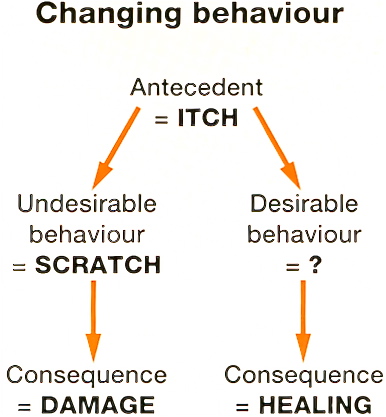Habit Reversal Tip #5: Changing Behaviour
|
author/source: DrB
 |
- Habit reversal of the habitual scratching of chronic atopic eczema requires initial consideration how established or learnt behaviour is changed, or modified. Habit reversal is a behaviour modification technique.
- The essential first step is therefore to be clear about the behaviour that needs changing - before trying to change it. For habitual scratching the behaviour is all touching, rubbing, picking and... scratching of the skin - all of the skin, including the scalp! Before changing a behaviour, the behaviour should be described carefully: how is it done, how often and when. Registration helps achieve this.
- Next the A, B, and C sequence of Antecedents, Behaviour and Consequences gives an important way of understanding the target behaviour, adding the need to change by calling the existing sequence undesirable, and the new sequence desirable. This is determined by the consequence - the antecedents will mostly have to stay the same, but if the behaviour changes, different consequences are possible.
- For example, the undesirable sequence of A. ITCH → B. SCRATCH→C. DAMAGE needs replacing by the desirable sequence of A. ITCH→ B. ALTERNATIVE to scratching (non-damaging)→C. HEALING
Note: It is often the case with the scratching of chronic atopic eczema that the antecedent is an activity, situation or circumstance - not an itch: habitual scratching is usually not due to itch
- The desirable consequence should re-inforce the desirable behaviour - and this re-inforcement allows learning to occur. Initially the process is conscious, but soon it becomes the new desirable habit - habit reversal is achieved!
The sequence that an undesirable behaviour is part of needs to be replaced so that the new desirable behaviour has the same antecendent, replaces the undesirable behaviour, and allows then a desirable consequence to emerge: when this is achieved the introduction of the new behaviour is re-inforced: with habit reversal, the new behaviour can become the new habit.
Any questions?
CONTACT US - or add a comment on Disqus below: happy to hear from you!
